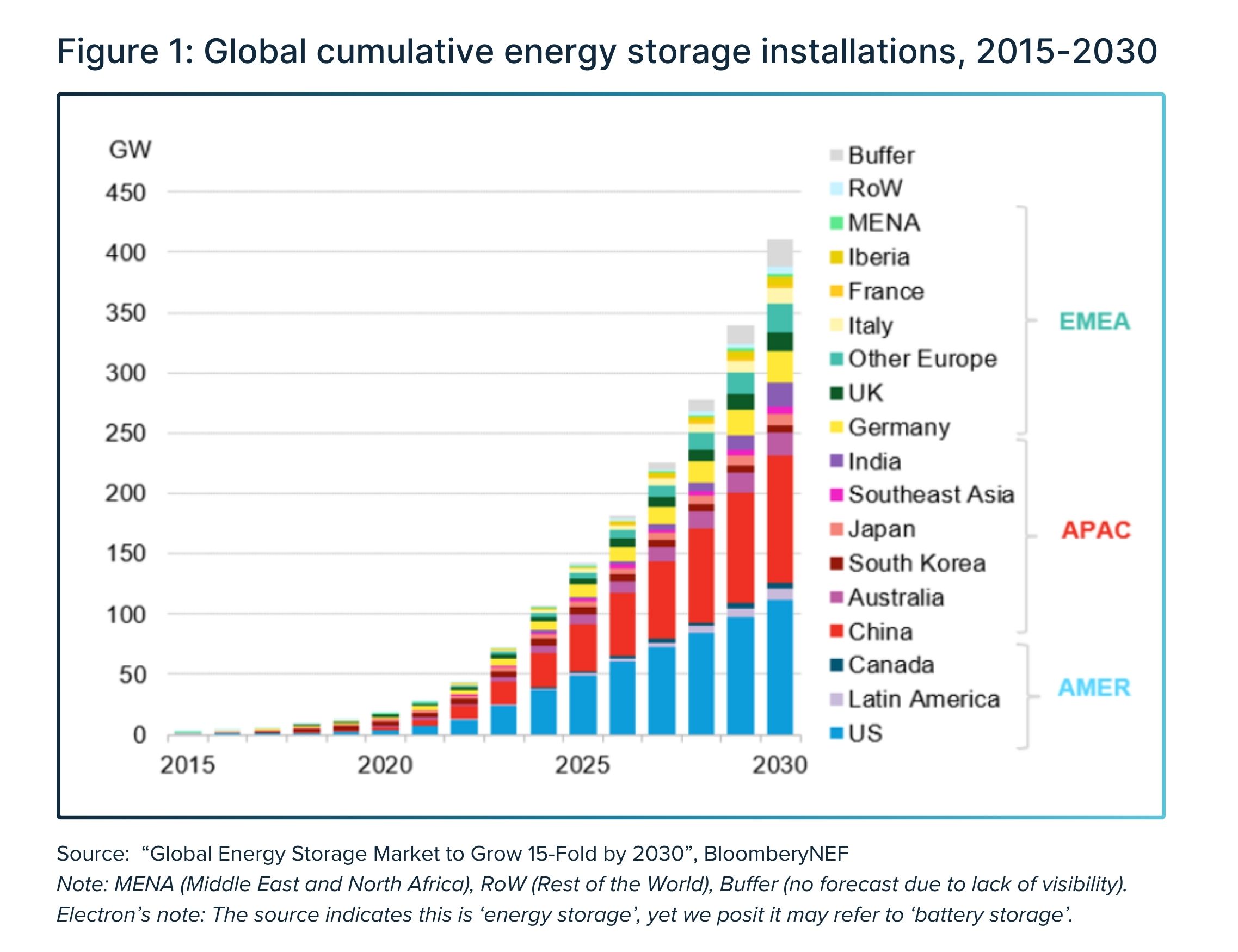Energy storage is a key component of providing flexibility to the grid. Energy (the power to do work) – such as from variable renewable resources – can be stored as electrical or heat energy, or in other forms, for use when needed. Storage therefore helps maintain grid reliability and is an essential part of an effective energy transition.
This guide to energy storage and flexibility covers:
- How does energy storage help bolster network flexibility?
- What are the most common forms of energy storage?
- What are the benefits of energy storage?
- How is energy storage flexibility being used in practice?
- How fast is the use of electricity storage growing?
How does energy storage help bolster network flexibility?
Power system flexibility requires the participation of generators, consumers, and storage to help balance the supply of electricity and ensure clean energy isn’t wasted.
Using the flexibility that storage provides can therefore help with load shifting and reducing the grid’s daily variation, with peaks in usage and generation.
In the UK, the use of flexible technology like batteries is expected to save the UK power system up to £40 billion by 2050.
What are the most common forms of energy storage?
The storage types below are proven technologies with a wide application, including contributing energy flexibility to the grid. Many other types of energy storage exist, but their application is likely limited to bespoke projects and atypical use cases.
Pumped Hydropower Storage (PHS)
Pumped Hydropower Storage (PHS) is the most established energy storage system at scale. This stores energy by pumping water from a low reservoir to a higher one. It then generates electricity when the water moves, under gravity, back down through a turbine.
This can be used for long-term storage. The energy stored is “potential energy”; the water can be released at any time to generate the necessary electricity.
Lithium-ion battery storage
Batteries – also known as battery energy storage systems (BESS) – can store the energy generated from renewable energy sources. That energy can be released when needed, converting chemical energy to electricity.
Lithium-ion batteries takes up the majority share in new battery storage system installations, at 92% of global battery storage installed capacity in 2020. Lithium-ion batteries are classed as a short-term energy storage system. They are ideal for energy storage which is stored and used in 24-hour cycles.
This is primarily thanks to the growth in EVs, which run on this battery type because it’s energy dense. That means it can be light for the amount of energy that it stores. The battery also has no moving parts which could be affected by movement in vehicles.
Green hydrogen
New technologies are also coming to the fore, such as hydrogen. Energy is converted through the chemical process of electrolysis, to be released later. When the energy used for the initial conversion comes from renewable sources such as wind or solar, this is known as “Green hydrogen”. That hydrogen can then be stored as a compressed gas for later use.
Hydrogen can store large amounts of energy for a long time. However, it has its fair share of challenges, with a low energy density, as well as needing to be stored at near absolute zero.
What are the other top benefits of energy storage?
Environmental benefits
Renewable energy is intermittent, meaning that it can’t simply be turned up and down at will to meet variable demand. Storing the renewable energy generated ensures it can be used when it’s required, rather than wasted.
By supporting more renewable energy, it therefore helps us reduce our reliance on fossil fuels, paving the way to Net Zero.
Security of supply
The adaptable use of renewable energy also contributes to network and grid resilience, helping to balance supply and demand.
Both long and short-term energy storage systems – as outlined above – are required to help balance grid and network requirements, particularly at times of peak demand, to help with the security of energy supply.
Energy storage systems are also able to be turned up and down quickly. In contrast, some conventional fossil fuel plants can take a long time to vary the amount of energy that they produce to meet changing demand.
Financial benefits
Batteries and energy storage can directly replace a portion of peaking power generators over time. The Clean Energy Council in Australia compared the running costs between a new gas-fired generator and a battery project, both at 250MW, in 2021. Battery storage was up to 30% cheaper for keeping the grid stable.
But, more than that – the efficiencies outlined above through using more low-carbon resources makes it much cheaper to run energy systems.
How is energy storage flexibility being used in practice?
Europe has made recommendations to support and strengthen the use of storage for delivering flexibility services. It suggests the creation of “well-designed network charges and tariff schemes” to reduce consumption from the grid during peak hours.
It also shares that storage can be particularly useful for regions under served by the grid. This limits how many renewables they can connect.
Moreover, storage is already being used in a very practical sense, to deliver flexibility to the grid.
Flexibility through Vehicle-to-Grid tariffs
Innovative solutions are using demand side assets in more flexible ways, to feed the energy stored back into the grid when needed. For example, vehicles spend a lot of their time stationary, so electric vehicles are a fast-growing network of energy storage.
With Vehicle-to-Grid (V2G) technology, Octopus Energy, a UK retailer, is now offering a tariff for EV owners with V2G-compatible vehicles and chargers.
The vehicles would need to be charged for around twelve hours a day every couple of days, and charge less than 333kWh per month. Those vehicles could travel around 1,000 miles a month for free, under this tariff. That energy can then be discharged back to the grid when required, to provide flexibility.
Demand Flexibility Service
Energy storage can also help consumers take full advantage of events such as those offered through the UK’s Demand Flexibility Service (DFS), says Connected Energy. For each DFS event, the consumer must reduce the amount of energy they use.
However, a consumer – whether residential or commercial – with energy storage can store energy in advance and use that energy at the time of the event, rather than taking it from the network. That means they can continue to use the same amount of energy but get paid for turning down and not using the energy from the network.
Unlocking flexibility in Virtual Power Plants
The use of battery storage is key to the optimal use of Virtual Power Plants (VPPs). These VPPs aggregate energy resources for network utilities and System Operators to access.
Aggregating solar power plus storage systems can ensure that solar energy can be stored and supplied to homes at peak times, even at night – and help avoid curtailment when generation is high.
How fast is the use of electricity storage growing?
Energy storage is growing rapidly across the globe. In the US, the total battery capacity installed is expected to rise to 31.1GW by the end of 2024 – an increase of 80% year on year.
The International Energy Agency has predicted that storage capacity around the globe will grow by 56% – reaching 270GW – by 2026. Various studies point to between 200 GW and 600 GW of energy storage capacity by 2030 and 2050 respectively – a jump from around 60 GW in 2022.
BloombergNEF forecasts that Asia Pacific will lead storage installations by 2030, thanks to China’s growing market in China, as figure 1 demonstrates.


